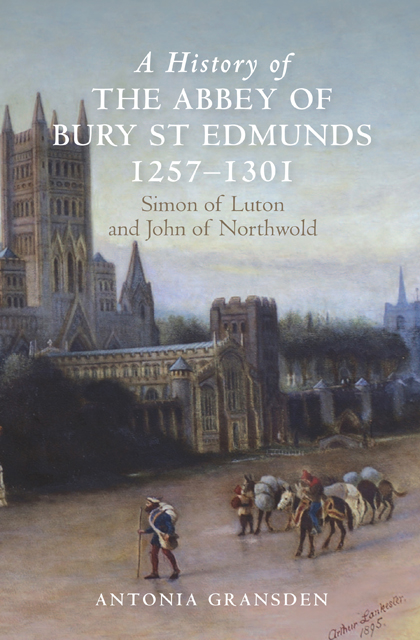Book contents
- Frontmatter
- Dedication
- Contents
- List of plates
- List of figures
- Preface
- Editorial note
- Dedication
- Acknowledgements
- Abbreviations
- Maps and plans (figures 1–11)
- Part I Introduction
- Part II Abbatial Governance
- Part III The Abbey’s Economy
- Part IV Religious Life and Reform
- Part V Intellectual and Cultural Life
- Appendix I The identity of the abbot’s justices, Henry of Guildford and Henry of Shenholt (in 1287)
- Appendix II The monks’ dietary regime: their food and drink
- Select List of the Registers and Customaries Cited
- Select List of Further Manuscripts Cited
- Select Bibliography
- Index
- Backmatter
Appendix II - The monks’ dietary regime: their food and drink
Published online by Cambridge University Press: 22 February 2023
- Frontmatter
- Dedication
- Contents
- List of plates
- List of figures
- Preface
- Editorial note
- Dedication
- Acknowledgements
- Abbreviations
- Maps and plans (figures 1–11)
- Part I Introduction
- Part II Abbatial Governance
- Part III The Abbey’s Economy
- Part IV Religious Life and Reform
- Part V Intellectual and Cultural Life
- Appendix I The identity of the abbot’s justices, Henry of Guildford and Henry of Shenholt (in 1287)
- Appendix II The monks’ dietary regime: their food and drink
- Select List of the Registers and Customaries Cited
- Select List of Further Manuscripts Cited
- Select Bibliography
- Index
- Backmatter
Summary
Recently the subject of diet – when people had their meals and what they ate and drank – has attracted much scholarly attention. Because of the nature of the evidence much of the work has inevitably concentrated on the later Middle Ages, that is, on the fourteenth and fifteenth centuries. For the same reason most studies (but not all) have dealt mainly with the diet of the baronial class, the aristocracy and royalty. Most works on their diet only touch tangentially on monastic diet. This was roughly the same as the diet of the baronage, but with the restrictions imposed on monks by their monastic vocation. However, Barbara Harvey has published two ground-breaking studies on monastic diet, one a substantial section in her Living and Dying, and the other an article on monastic pittances. Her expertise lies especially in the later Middle Ages and tends to concentrate on the history of Westminster Abbey. Her unrivalled knowledge of that abbey’s rich archives has established her pre-eminent authority on its history particularly, but not exclusively, in the later Middle Ages. Therefore, it seems appropriate here to compare the dietary customs and practices of the abbot and monks of Westminster with those of St Edmunds, and also to survey the dietary customs and practices observed at St Edmunds itself, in so far as they can be known.
The nature of the evidence for St Edmunds is very different from that available for Westminster. Barbara Harvey based her study on exhaustive examination mainly of the magnificent series of the obedientiary and other account rolls preserved in Westminster abbey which date from the late thirteenth century almost until the dissolution of the abbey in 1540. St Edmunds has no comparable continuous series but instead it has a superb collection of registers and customaries. The present survey relies on these sources and the result will be a much less precise and less detailed study than Harvey’s. However, it is to be hoped that it will give some impression of the dietary customs and practices of the monks of St Edmunds. It concentrates on the thirteenth century, but cites earlier evidence when applicable, and is divided into three sections: the dietary regime; drink; and food.
- Type
- Chapter
- Information
- A History of the Abbey of Bury St Edmunds, 1257-1301Simon of Luton and John of Northwold, pp. 295 - 320Publisher: Boydell & BrewerPrint publication year: 2015



